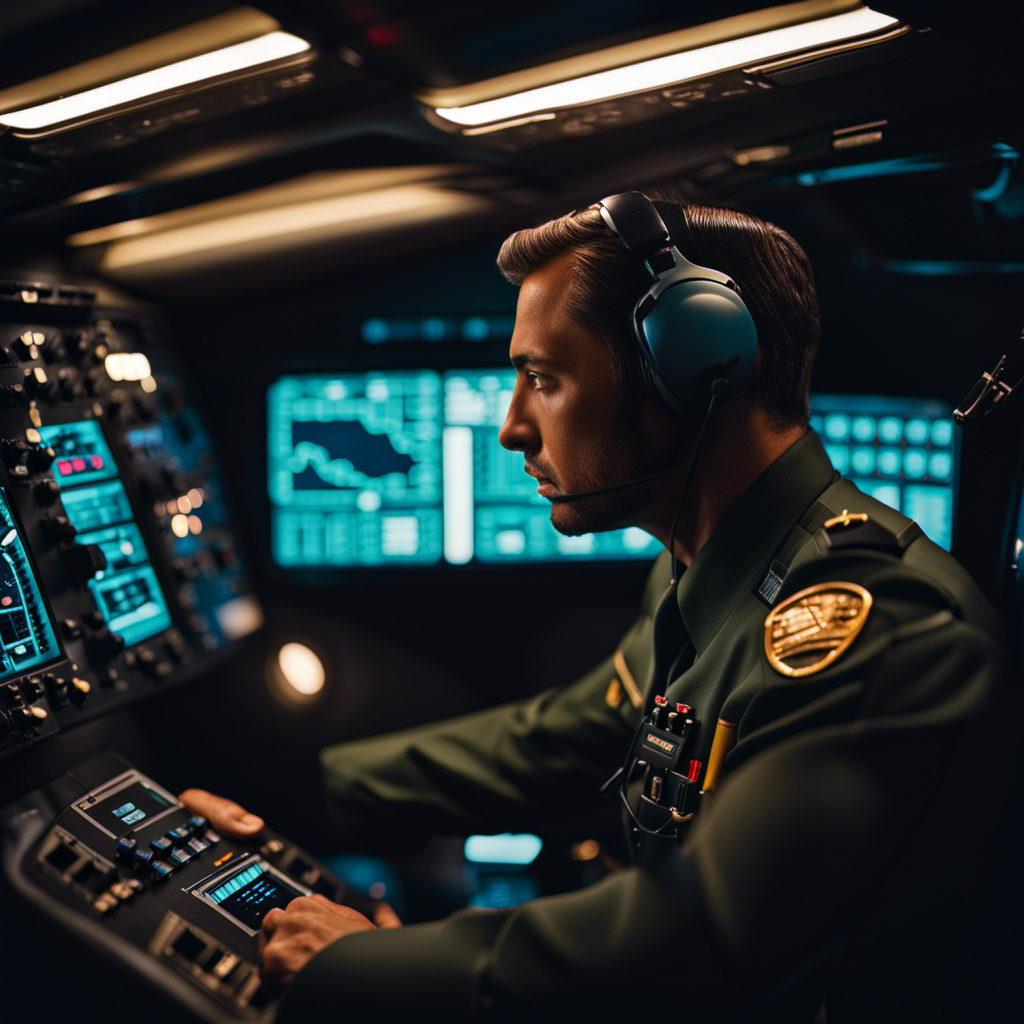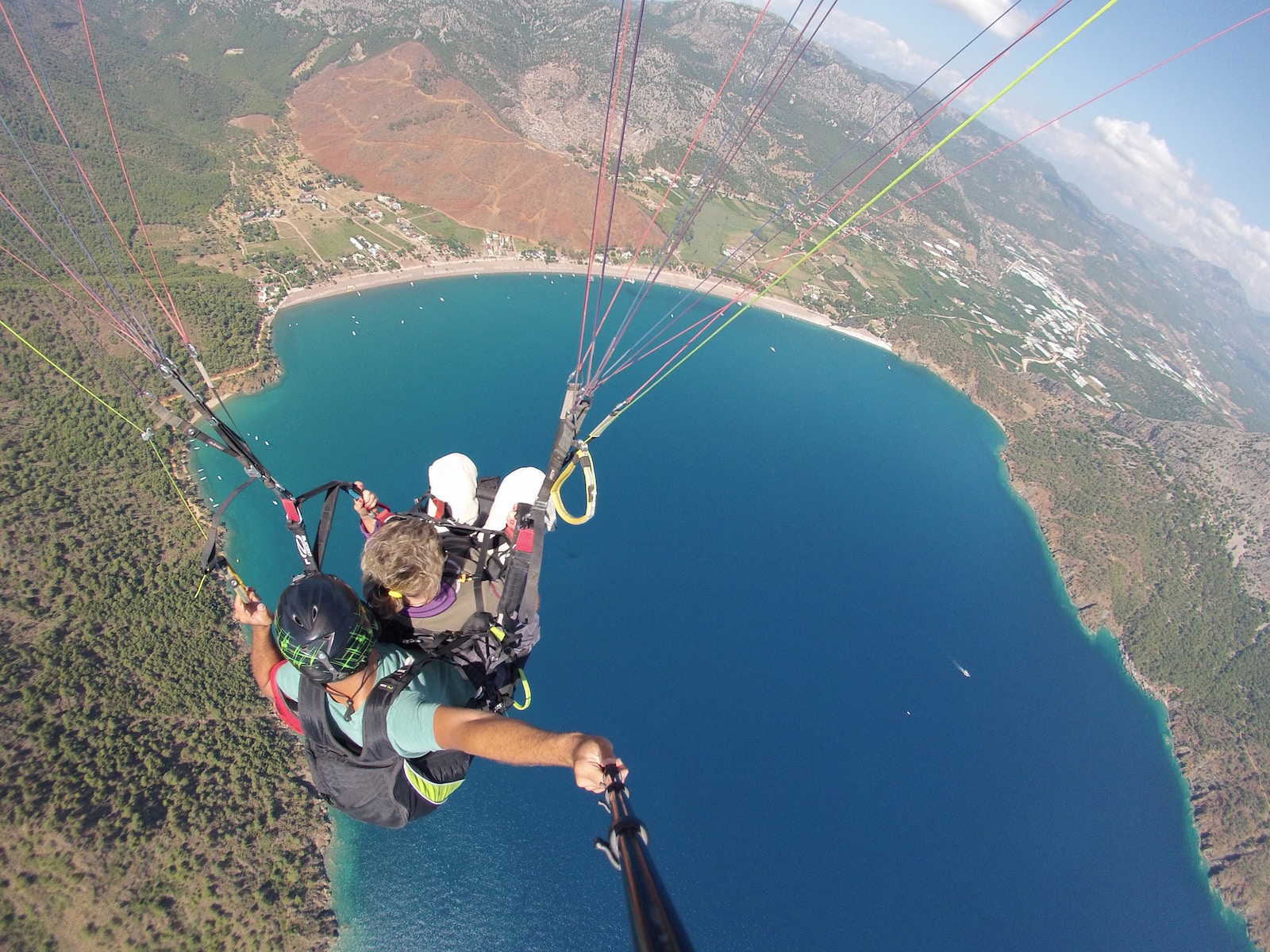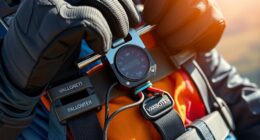As an experienced pilot, I know firsthand the importance of staying alert during flights. The thought of dozing off while in control is a scary scenario that emphasizes the risks involved.
But just how common is it for pilots to fall asleep in the cockpit?
In this article, we will explore the factors that contribute to pilot fatigue, the impact of sleep deprivation on performance, and the measures in place to prevent such incidents.
So fasten your seatbelts and join me on this journey into the world of pilot alertness.
Key Takeaways
- Sleep deprivation and fatigue can significantly impact pilot performance, leading to decreased alertness, impaired decision-making, and increased risk of errors.
- Regulations and guidelines for pilot rest and sleep, including duty and rest requirements, sleep disorder screening, and fatigue risk management programs, aim to mitigate the effects of sleep deprivation and fatigue on pilots.
- Technology and tools such as cockpit voice recorders, flight data monitoring systems, and fatigue detection systems can be used to monitor pilot alertness and identify potential fatigue-related risks.
- Implementing effective fatigue management programs, prioritizing rest and sleep, and promoting awareness of fatigue-related risks are crucial strategies in the aviation industry to ensure flight safety and reduce fatigue-related incidents.
The Importance of Pilot Alertness in Flight Safety
Pilot alertness is crucial in ensuring flight safety. Factors affecting pilot alertness can include fatigue, sleep deprivation, and circadian rhythms.
One key factor that contributes to pilot fatigue is the role of circadian rhythms. These are the body’s internal clock that regulates our sleep-wake cycle. Pilots often experience disruptions to their circadian rhythms due to irregular work schedules and long flights across multiple time zones. This can lead to fatigue and decreased alertness during critical phases of flight.
Understanding the factors that contribute to pilot fatigue is essential in developing strategies to mitigate its effects and promote flight safety. By identifying and addressing these factors, we can take steps towards reducing the risk of fatigue-related incidents in aviation.
Understanding the Factors that Contribute to Pilot Fatigue
Understanding the factors that contribute to pilot fatigue can help improve flight safety. There are several key factors that influence pilot fatigue levels, which can have serious implications on their decision-making abilities.
These factors include:
-
Sleep deprivation: Lack of sufficient sleep due to long duty hours or irregular work schedules can greatly contribute to pilot fatigue. This can impair their cognitive functioning and reaction times, increasing the risk of errors or poor judgment.
-
Circadian rhythm disruption: Frequent travel across time zones can disrupt pilots’ internal body clocks, leading to fatigue and reduced alertness during critical phases of flight.
-
Workload and stress: High workload and stressful situations can exacerbate fatigue levels, as pilots may struggle to manage multiple tasks effectively and make optimal decisions.
Understanding these factors is crucial for implementing effective fatigue management strategies in the aviation industry.
Now, let’s delve into the impact of sleep deprivation on pilot performance…
The Impact of Sleep Deprivation on Pilot Performance
To improve your flight performance, it’s essential to recognize how sleep deprivation can negatively affect your abilities as a pilot. The effects of sleep deprivation on cognitive function and the impact of fatigue on decision-making skills cannot be underestimated. When pilots are sleep deprived, their ability to focus, make quick and accurate judgments, and respond to emergencies is impaired. This can put the safety of the flight and passengers at risk. Take a look at the table below to see some specific ways sleep deprivation can affect pilot performance:
| Effects of Sleep Deprivation | Impact on Pilot Performance |
|---|---|
| Decreased alertness | Slower reaction times |
| Impaired memory | Poor decision-making |
| Reduced attention span | Difficulty multitasking |
Understanding these effects is crucial for pilots to prioritize their rest and ensure they are well-rested before every flight. Transitioning into the subsequent section about regulations and guidelines for pilot rest and sleep, it’s important to have clear guidelines in place to prevent fatigue-related accidents.
Regulations and Guidelines for Pilot Rest and Sleep
The regulations and guidelines for pilot rest and sleep are crucial in ensuring the safety and well-being of flight crews. These rules are designed to address the unique challenges that pilots face in maintaining proper sleep schedules and managing sleep disorders.
Here are three important aspects of these regulations:
-
Duty and rest requirements: The regulations specify the maximum number of hours a pilot can be on duty and the minimum amount of rest they must have between flights. This helps prevent fatigue and ensures pilots have adequate time for restorative sleep.
-
Sleep disorder screening: Pilots are required to undergo regular screenings for sleep disorders, such as sleep apnea. Identifying and treating these disorders is essential for maintaining the alertness and cognitive function necessary for safe flying.
-
Fatigue risk management programs: Airlines are encouraged to implement fatigue risk management programs that incorporate scientific principles to optimize pilot rest and mitigate the risks associated with fatigue.
These regulations and guidelines aim to create a safe and well-rested pilot workforce, reducing the likelihood of sleep-related incidents during flights.
As we explore technology and tools to monitor pilot alertness, it becomes evident that these regulations form the foundation for ensuring the effectiveness of such systems in maintaining pilot vigilance and preventing accidents.
Technology and Tools to Monitor Pilot Alertness
When it comes to monitoring pilot alertness, there are several technology and tools available.
Cockpit voice recorders and flight data monitoring systems are used to gather data on pilot performance and identify any signs of fatigue or lapses in attention.
Fatigue detection systems and wearable devices can also be utilized to track vital signs and detect signs of drowsiness or fatigue.
Additionally, pilot self-assessment tools and sleep diary apps can help pilots track their own alertness levels and identify patterns or trends in their sleep habits that may affect their performance.
Cockpit voice recorders and flight data monitoring
Pilots use cockpit voice recorders and flight data monitoring to enhance safety during flights. These tools provide valuable information that can help identify potential risks and improve pilot performance.
One area where this technology is particularly useful is in monitoring pilot fatigue. Fatigue monitoring technology, such as wearable devices, can track pilot sleep patterns and provide real-time data on their alertness levels. This information can then be combined with data from cockpit voice recorders and flight data monitoring systems to analyze factors that may contribute to fatigue, such as long duty hours or disrupted sleep schedules.
Fatigue detection systems and wearable devices
Fatigue detection systems and wearable devices can accurately monitor pilot sleep patterns and alertness levels. This wearable technology plays a crucial role in fatigue monitoring, ensuring the safety of pilots and passengers alike. These devices use advanced sensors to track vital signs, eye movement, and brain activity, providing real-time data on the pilot’s fatigue levels. By analyzing this data, the system can identify potential signs of fatigue and alert the pilot or ground crew. To illustrate the importance of such technology, consider the following table:
| Wearable Device | Function |
|---|---|
| Smartwatch | Monitors heart rate, sleep patterns, and activity levels |
| Electroencephalogram (EEG) Headband | Measures brain activity and detects drowsiness |
| Eye-Tracking Glasses | Tracks eye movements and detects signs of fatigue |
These fatigue detection systems revolutionize aviation safety by enabling proactive measures to prevent accidents caused by pilot fatigue. However, they are not the only tools available. Pilot self-assessment tools and sleep diary apps also aid in managing fatigue and will be discussed in the next section.
Pilot self-assessment tools and sleep diary apps
Sleep diary apps and pilot self-assessment tools are effective resources for managing fatigue and promoting better sleep habits. These pilot sleep tracking and fatigue management tools allow pilots to accurately track and analyze their sleep patterns, helping them identify any irregularities or sleep disturbances that may contribute to fatigue.
By regularly monitoring their sleep quality and quantity, pilots can make informed decisions about their rest periods and adjust their schedules accordingly. Additionally, these tools enable pilots to assess their own levels of fatigue, providing them with valuable insight into their mental and physical state before and during flights.
By utilizing these self-assessment tools, pilots can take proactive steps to manage their fatigue and ensure they are fit to fly.
Transitioning into the subsequent section about training and education for pilot fatigue management, it is important for pilots to receive comprehensive training and education on recognizing and addressing fatigue-related issues.
Training and Education for Pilot Fatigue Management
As a pilot, it’s crucial to recognize the signs of fatigue in order to maintain safety and prevent accidents. Effective sleep strategies and napping techniques can greatly improve alertness and performance during flights.
Additionally, stress management and adopting healthy lifestyle habits are essential for managing fatigue and ensuring optimal pilot performance.
Recognizing the signs of fatigue
You can identify the signs of tiredness by paying attention to your body’s signals. Fatigue management techniques are crucial for pilots to ensure they are alert and capable of making sound decisions. When fatigue sets in, it can have a significant impact on decision making, increasing the risk of errors and accidents.
Some common signs of fatigue include yawning, difficulty concentrating, and feeling irritable or moody. Physical symptoms may include heavy eyelids, blurry vision, and slower reaction times. It’s important to recognize these signs early on and take appropriate action to prevent fatigue from compromising safety.
In the next section, we will discuss effective sleep strategies and napping techniques to help pilots combat fatigue and stay alert in the cockpit.
Effective sleep strategies and napping techniques
Transition: Now that we understand the signs of fatigue, let’s explore effective sleep strategies and napping techniques to ensure pilots stay alert and focused during their flights.
Current Subtopic: Effective sleep strategies and napping techniques
-
Consistent sleep routines: Establishing regular sleep patterns helps regulate our body’s internal clock, promoting better quality sleep and reducing the risk of fatigue.
-
Pre-sleep rituals: Engaging in relaxing activities before bedtime, such as reading or taking a warm bath, can signal our bodies that it’s time to wind down and prepare for sleep.
-
Power naps: Short naps of around 20 minutes have been shown to improve alertness and performance, providing a quick recharge without interfering with nighttime sleep.
By implementing these strategies, pilots can optimize their sleep and combat fatigue, ensuring they are well-rested for their flights.
This leads us to the next section, where we will discuss stress management and healthy lifestyle habits to further enhance pilot well-being and performance.
Stress management and healthy lifestyle habits
Stress management is essential for maintaining pilot well-being and performance. As pilots, we face constant pressure and demands, which can take a toll on our mental and physical health.
To effectively manage stress, it is crucial to adopt stress management techniques and develop healthy sleep habits. Some stress management techniques include deep breathing exercises, meditation, and engaging in physical activity.
Additionally, establishing a consistent sleep schedule, creating a relaxing bedtime routine, and ensuring a comfortable sleep environment are all key to maintaining healthy sleep habits.
By implementing these strategies, we can reduce stress levels, improve our overall well-being, and enhance our performance in the cockpit.
Transitioning into the next section, it is important to recognize the significance of these techniques in preventing incidents related to pilot fatigue.
Case Studies of Incidents Related to Pilot Fatigue
One notable incident involving pilot fatigue occurred in 2008 when a plane overshot its destination by 150 miles. This incident highlights the serious consequences of pilot fatigue and the need for effective measures to prevent it.
Several case studies have been conducted to understand the impact of pilot fatigue on aviation safety. These studies have revealed alarming findings, including instances of pilots falling asleep during flights, making critical errors, and experiencing impaired decision-making abilities.
The case studies emphasize the importance of addressing pilot fatigue to ensure the well-being of both pilots and passengers. By understanding the factors that contribute to fatigue and implementing appropriate countermeasures, collaborative efforts can be made to mitigate the risks associated with pilot fatigue and enhance flight safety.
Collaborative Efforts to Address Pilot Fatigue
When it comes to addressing pilot fatigue, there are several key points to consider.
Firstly, the International Civil Aviation Organization (ICAO) sets standards and guidelines that aim to ensure the safety and well-being of pilots.
Secondly, airline policies and pilot union negotiations play a crucial role in implementing strategies and measures to prevent and mitigate fatigue-related incidents.
Lastly, ongoing research and development efforts are focused on finding effective fatigue countermeasures that can enhance pilot alertness and performance.
International Civil Aviation Organization (ICAO) standards
To ensure safety, you should be aware that International Civil Aviation Organization (ICAO) standards address the issue of pilots falling asleep while flying. These standards focus on pilot fatigue management and the implementation of sleep deprivation countermeasures.
The ICAO recognizes the importance of mitigating the risks associated with pilot fatigue, as it can significantly impair a pilot’s ability to perform their duties effectively. To combat this issue, the ICAO emphasizes the need for airlines to establish comprehensive fatigue risk management systems. These systems include policies and procedures aimed at minimizing pilot fatigue, such as duty time limitations, rest requirements, and scheduled breaks.
By adhering to these standards, airlines can ensure that their pilots are well-rested and alert during flights.
In the next section, we will explore how airline policies and pilot union negotiations contribute to addressing pilot fatigue without using the word ‘step’.
Airline policies and pilot union negotiations
After establishing the International Civil Aviation Organization (ICAO) standards, it is crucial to examine how airlines address the issue of pilot fatigue management. Airlines play an essential role in implementing policies and procedures to ensure the well-being and alertness of their pilots.
These policies often involve setting limits on the number of flight hours, providing adequate rest periods between flights, and conducting regular fatigue risk assessments. Pilot union negotiations also play a significant role in shaping these policies, as unions advocate for the best interests of their members.
It is important to note that airlines bear a level of liability when it comes to pilot fatigue management. In the event of an accident caused by pilot fatigue, airlines can be held accountable for not adequately addressing this issue. This liability further emphasizes the importance of effective fatigue management strategies in the aviation industry.
Transitioning into the subsequent section on the research and development of fatigue countermeasures, it is crucial to explore the proactive steps taken to mitigate the risks associated with pilot fatigue.
Research and development of fatigue countermeasures
You should explore the advancements in research and development of fatigue countermeasures to understand how the aviation industry is actively addressing the issue of pilot fatigue.
-
Fatigue research: Scientists are conducting extensive studies on the effects of fatigue on pilots to better understand its impact on their performance and safety.
-
Fatigue management techniques: Airlines are implementing various strategies to manage pilot fatigue. These strategies include scheduling practices that allow for adequate rest, implementing fatigue risk management systems, and providing education and training on fatigue awareness and management.
-
Technology advancements: The aviation industry is investing in the development of innovative technologies. These technologies include wearable devices and cockpit alert systems that can detect and prevent fatigue-related incidents.
Passenger Safety Measures in Place
As a pilot, I’m responsible for ensuring the safety of my passengers at all times.
During my rest periods, the co-pilot takes on the responsibility of monitoring the aircraft and maintaining communication with air traffic control.
The use of autopilot and automated flight systems also assist in maintaining the aircraft’s stability and course, allowing the pilot and co-pilot to focus on other tasks.
Additionally, cabin crew members undergo extensive training on emergency procedures to ensure they can respond effectively in case of any unforeseen events during the flight.
Co-pilot responsibilities during pilot rest periods
During pilot rest periods, it’s important for co-pilots to fulfill their responsibilities. Effective co-pilot communication and coordination is essential to ensure a smooth and safe flight. Co-pilots must maintain constant contact with the pilot on duty, exchanging vital information about the flight progress, weather conditions, and any potential issues.
Additionally, co-pilots play a crucial role in managing the pilot rest schedules. They must ensure that the pilot gets sufficient rest during designated rest periods, allowing them to remain alert and focused when taking over the controls. By effectively managing the pilot rest schedules and maintaining clear communication, co-pilots contribute to the overall safety and efficiency of the flight.
Now, let’s delve into the role of autopilot and automated flight systems in ensuring a secure and comfortable journey for passengers.
Autopilot and automated flight systems
The use of autopilot and automated flight systems in modern aviation has significantly improved the safety and efficiency of air travel. These advancements in autopilot technology have revolutionized the way airplanes are flown, allowing for precise navigation and reducing the workload on pilots. Here are four key benefits of autopilot advancements and human machine interaction in aviation:
-
Enhanced safety: Autopilot systems can maintain a steady course, altitude, and speed with remarkable accuracy, reducing the risk of human error.
-
Increased fuel efficiency: Automated flight systems optimize fuel consumption by calculating the most economical routes and adjusting engine settings accordingly.
-
Reduced pilot workload: Autopilot takes care of routine tasks, allowing pilots to focus on critical decision-making and monitoring flight conditions.
-
Improved passenger comfort: With autopilot in control, the aircraft can maintain a smooth and stable flight, minimizing turbulence and providing a more comfortable experience for passengers.
As we explore the benefits of autopilot and automated flight systems, it is important to also consider the training and preparedness of cabin crew on emergency procedures.
Cabin crew training on emergency procedures
As we explored the role of autopilot and automated flight systems in the previous section, it is essential to shift our focus to another crucial aspect of aviation safety: cabin crew training on emergency procedures.
The cabin crew plays a vital role in ensuring the safety and well-being of passengers during flights. They are trained extensively in various emergency scenarios, including emergency evacuations. Effective cabin crew communication is key in such situations, as it ensures a coordinated and swift response.
Through rigorous training programs, cabin crew members are taught how to effectively communicate emergency procedures to passengers, maintaining calm and order. They are trained to handle situations such as fires, water landings, and even aircraft evacuations. Their knowledge and expertise in emergency procedures contribute significantly to the overall safety of the flight.
Transitioning into the subsequent section about ‘future trends and innovations in pilot fatigue prevention,’ it is crucial to address the issue of pilot fatigue to ensure optimal flight safety.
Future Trends and Innovations in Pilot Fatigue Prevention
One potential solution to pilot fatigue could be the development of new technologies that help prevent pilots from falling asleep while flying. With the advancement of future technologies, there are several innovative solutions being explored.
These include:
- Wearable devices that monitor pilot’s vital signs and alert them if they show signs of drowsiness.
- Cockpit automation systems that can detect fatigue-related performance decrements and intervene to prevent accidents.
- Virtual reality training programs that simulate real-life scenarios and help pilots improve their sleep hygiene.
These technologies aim to improve flight safety by addressing the issue of pilot fatigue. By implementing these advancements, pilots can have a better understanding of their physical condition and take necessary measures to stay alert during flights.
Additionally, promoting good sleep hygiene through virtual reality training can contribute to reducing fatigue-related incidents in the aviation industry.
Frequently Asked Questions
How many pilots fall asleep while flying on average?
On average, pilot sleep patterns are monitored through average statistics. It is important to understand the factors that contribute to pilot fatigue and ensure proper rest to prevent sleep-related incidents while flying.
What are the main causes of pilot fatigue?
Main causes of pilot fatigue include long work hours, irregular schedules, and inadequate rest. These factors can impact performance, leading to decreased alertness and increased risk of errors. It’s ironic how fatigue, a common issue, jeopardizes safety in the skies.
Are there any regulations in place to ensure pilots get enough rest?
Yes, there are regulations in place to ensure pilot rest. These regulations set limits on duty time, require minimum rest periods, and establish maximum flight hours per day and week.
What technologies are used to monitor pilot alertness?
Pilot monitoring technologies, such as sleep tracking systems, are used to ensure alertness. These technologies track pilots’ sleep patterns to identify any potential fatigue or sleep deprivation issues that may affect their performance during flights.
What training and education programs are available to help pilots manage fatigue?
Pilot fatigue management is crucial for aviation safety. Various training and education programs help pilots develop strategies for preventing fatigue, such as implementing proper rest schedules and utilizing fatigue risk management systems.
Conclusion
In conclusion, it’s mind-boggling to imagine just how many pilots fall asleep while flying. The alarming reality is that fatigue can severely impact a pilot’s performance, putting passengers’ lives at risk.
Thankfully, regulations and guidelines are in place to ensure pilot rest and sleep. Additionally, technology is being developed to monitor pilot alertness.
However, we must continue to collaborate and innovate to prevent pilot fatigue. Our ultimate goal should be to ensure the highest level of safety for all those who take to the skies.
Orion, better known as “Jetstream,” is the voice that brings the stories of the skies to life. His fascination with aviation began at a young age, sparked by his father’s tales of flying and adventure. Orion’s journey into the world of gliding was serendipitous, and from the moment he took his first glider flight, he knew he had found his calling.










